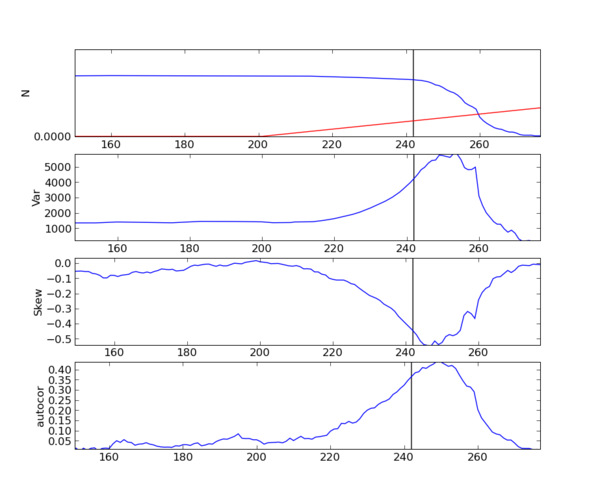- Discussion of cases where variance decreases before crash – misleading warning signals. Schreiber 2003
- Aaron King and Bill Schaffer JMB Hamiltonian vs Dissipative/gradient systems. Are Hamiltonian systems non-biological?
- Follow up with Darren
Reasons Warning Signals fail
- Present (saddle-node model) but insufficient sensitivity to detect (lack ensembles, lack sampling frequency)
- dissipative but warning signals are backwards (other higher dimensional bifurcations, limit cycles –> no potential)
- Hamiltonian instead of dissipative (centers, stochastically become random walks)
Code Updates
Early warning signals code now does ensemble averaging, which works! The next step is to compute variance around the ensemble average to determine significance of a signal.

The red line shows the environmental change, which begins around t = 200. The black line shows when the environmental variable hits the bifurcation point. Hence a reliable warning signal should occur between these two points. Looks like these work! Note that expected variance appears the least noisy. Dynamics of the model are 
With
| e | 0.5 |
| K | 1000 |
| h | 200 |
and the bifurcation occurs near a = 200.
Progress on Code
r19 | cboettig | 2010-02-18 00:58:00 -0800 (Thu, 18 Feb 2010) | 2 lines
early warning works with ensemble averaging. This commit is paired with the figure in the Feb 17 2010 entry in the openwetware notebook
r18 | cboettig | 2010-02-17 23:16:20 -0800 (Wed, 17 Feb 2010) | 2 lines
minor fixes to warning_signals
r17 | cboettig | 2010-02-17 23:06:41 -0800 (Wed, 17 Feb 2010) | 1 line
Completed implementation of ensemble averaging
r16 | cboettig | 2010-02-17 21:04:23 -0800 (Wed, 17 Feb 2010) | 1 line
src directory uncessary, moved code up